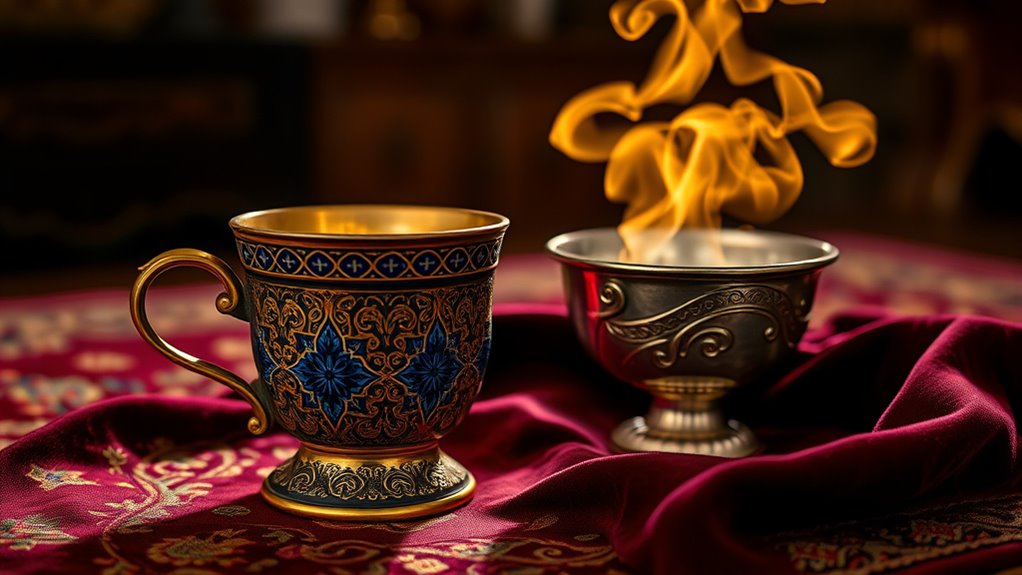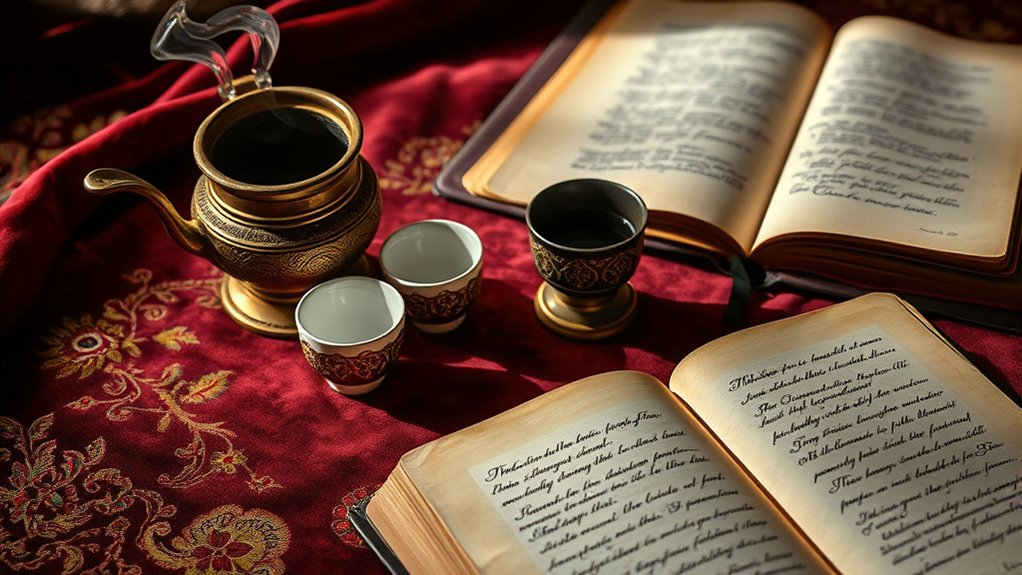Ottoman coffee plays a essential role in Turkish literature, symbolizing community, hospitality, and cultural pride. In poetry and prose, it captures moments of friendship, resilience, and tradition, reflecting the social life of the Ottoman era. Coffee’s aroma and rituals evoke emotions and serve as metaphors for connection and continuity. Its portrayal highlights the blending of old customs with modernity, revealing deeper values and struggles. To explore how these themes unfold, keep exploring this rich literary history.
Key Takeaways
- Ottoman coffee in literature symbolizes community, hospitality, and cultural pride, serving as a metaphor for social bonds and collective memory.
- Coffeehouses are depicted as vibrant spaces for dialogue, representing social diversity and blending tradition with modernity.
- Literary works often use coffee to evoke themes of fleeting pleasure, patience, resistance, and resilience within Ottoman society.
- Descriptions of coffee rituals and aromas enrich narratives, highlighting moments of conviviality and cultural continuity.
- Ottoman coffee in poetry and prose reflects evolving cultural identities and embodies deeper values of resilience, community, and emotional connection.

Have you ever wondered how Ottoman coffee has left its mark on literature? It’s more than just a beverage; it’s a symbol woven into the fabric of cultural narratives and literary expressions. Coffee symbolism in Ottoman poetry and prose captures the essence of social life, spiritual reflection, and political identity. When you explore into classic texts, you’ll notice that coffee often represents community, hospitality, and the fleeting nature of time. It’s a metaphor for connection, a catalyst for dialogue, and sometimes a subtle protest against change. Through the centuries, writers transformed coffee from a simple drink into a literary device that embodies intimacy and cultural pride.
Ottoman coffee symbolizes community, hospitality, and cultural pride in literature and social life.
In Ottoman literature, coffee’s role extends beyond its physical presence. It becomes a lens through which writers explore human emotions, societal values, and collective memory. You’ll find that poets describe coffeehouses as vibrant hubs for conversation, where ideas ferment alongside the brew. These spaces are portrayed as microcosms of the empire’s diverse society, blending different social classes and ethnicities. As a symbol, coffee reflects the fluidity of cultural narratives—how traditions evolve while maintaining a sense of shared identity. Writers often depict coffee as a bridge between the old and new, a marker of continuity amid change. It’s a symbol of hospitality, a gesture of welcoming guests into a space of openness and exchange.
Moreover, coffee’s cultural symbolism in Ottoman literature often hints at deeper philosophical themes. When you read poetry that mentions coffee, it might evoke notions of fleeting pleasure, the transient nature of life, or the importance of savoring moments. Writers use coffee to explore ideas of patience, moderation, and the pursuit of happiness. It’s also a subtle symbol of resistance—an act of cultural pride in the face of external influences. Through these narratives, coffee becomes a silent witness to history, embodying resilience and tradition. The way authors describe the aroma, the ritual of preparation, or the conviviality of the coffeehouse enriches the cultural layers embedded in their stories.
Ultimately, Ottoman coffee’s literary presence encapsulates a complex web of symbolism and cultural narratives. It invites you to see beyond the surface—to recognize how a simple cup of coffee can carry centuries of meaning. It reminds you that in literature, as in life, the stories we tell about everyday objects reveal our deepest values, struggles, and hopes. Ottoman coffee, in poetry and prose, continues to serve as a powerful symbol—one that celebrates community, preserves cultural identity, and sparks reflection on the human condition.
Frequently Asked Questions
How Did Ottoman Coffee Influence Early Turkish Visual Arts?
You see that Ottoman coffee deeply influences early Turkish visual arts through coffee symbolism and artistic representations. Artists incorporated coffee cups, brewing scenes, and related motifs into their works, reflecting its cultural significance. This imagery symbolizes hospitality, social bonds, and everyday life, making coffee a central theme. By doing so, visual arts preserved and celebrated the coffee’s role in Turkish society, connecting tradition with artistic expression.
What Are the Regional Variations of Ottoman Coffee Rituals?
You’ll notice regional variations of Ottoman coffee rituals through distinct customs and brewing techniques. In some areas, you might see thicker, more concentrated brews, while others prefer lighter, spiced versions. Local customs influence how coffee is served, whether with sweets or shared during social gatherings. These regional differences reflect cultural diversity, making each coffee experience unique and enriching your appreciation of Ottoman traditions across different regions.
How Did Ottoman Coffee Shape Social Hierarchies and Class Distinctions?
You see, Ottoman coffee played a crucial role in shaping social hierarchies through coffee etiquette, which reinforced class distinctions. As a member of higher classes, you’d follow refined manners, like serving coffee in specific settings, signaling your status. Meanwhile, lower classes had simpler rituals. This social stratification around coffee created clear divisions, allowing you to recognize and maintain your place within Ottoman society through these cultural practices.
Are There Specific Ottoman Poets Renowned for Coffee-Themed Poetry?
You’ll find poets like Nedim and Fuzuli renowned for coffee-themed poetry. They use poetry symbolism and coffee metaphors to explore love, longing, and social life. Their verses vividly depict coffee’s aroma and flavor, elevating it as a symbol of hospitality and cultural identity. By weaving these metaphors into their poetry, they capture the essence of Ottoman social customs, making coffee a central motif in their literary expressions.
How Did Ottoman Coffee Culture Spread to Neighboring Regions?
Think of Ottoman coffee culture as a spark igniting a wildfire along trade routes. You see, through vibrant trade networks and cultural exchanges, coffee spread from the Ottoman Empire to neighboring regions like North Africa, the Middle East, and parts of Europe. As merchants and travelers carried their love for coffee, it became intertwined with local customs, transforming into a shared symbol of hospitality and social bonding across diverse societies.
Conclusion
As you’ve explored, Ottoman coffee weaves through poetry and prose like a delicate thread in a rich tapestry, embodying more than just a beverage. It’s a symbol of social bonds, cultural identity, and poetic inspiration, standing as a silent witness to history’s unfolding. Through your journey, you’ve seen how coffee’s aroma lingers in literature, forever nourishing the soul much like the stories it inspired—an eternal flame that continues to warm hearts across centuries.








